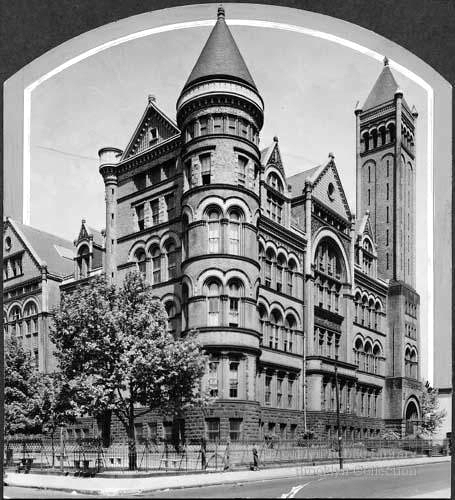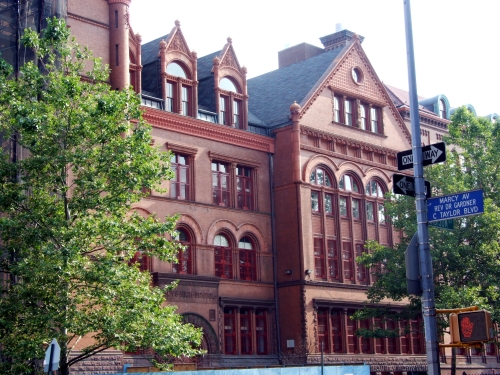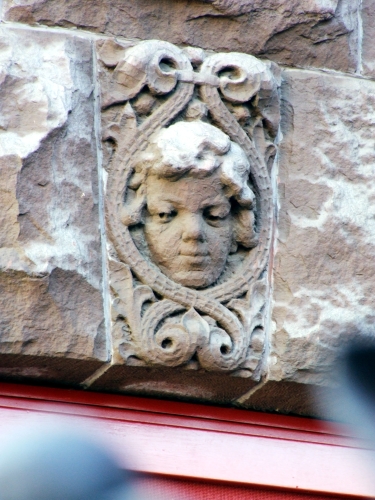Building of the Day: 832 Marcy Avenue
Brooklyn, one building at a time. Name: Boys High School Address: 832 Marcy Avenue Cross Streets: Putnam Avenue and Madison Street Neighborhood: Bedford Stuyvesant Year Built: 1891-2, with additions 1905-1910 Architectural Style: Romanesque Revival Architect: James W. Naughton; additions by C.B.J. Snyder Other works by architect: Girls High School in Bed Stuy; P.S. 9 Annex…

Brooklyn, one building at a time.
Name: Boys High School
Address: 832 Marcy Avenue
Cross Streets: Putnam Avenue and Madison Street
Neighborhood: Bedford Stuyvesant
Year Built: 1891-2, with additions 1905-1910
Architectural Style: Romanesque Revival
Architect: James W. Naughton; additions by C.B.J. Snyder
Other works by architect: Girls High School in Bed Stuy; P.S. 9 Annex in Prospect Heights; P.S. 107 in Park Slope. Snyder: Erasmus High School in Flatbush; John Jay High School in Park Slope. For both, many, many others
Landmarked: Yes, individually landmarked in 1975; National Register, 1982
The story: I’ve written about this school before, and it will always appear on my top ten list of best buildings in Brooklyn, but it’s never been a BOTD, so in honor of a new year, let’s start 2013 with a superior building. This is certainly one of the architectural jewels of Brooklyn, and is a testament to a whole fortuitous convergence of people, events and philosophies. It’s also a testament to the importance of Bedford as a prestigious neighborhood, as this was Brooklyn’s shining educational masterpiece when it was built, and still stands as one of the city’s finest schools. And how could it not? It’s been touched by not only one, but two masters of school architecture.
Brooklyn, as an independent city, led the metropolitan area in public education. Educators had long felt that public schooling beyond elementary school was necessary for an educated populace and work force. In 1885, the first high school in New York City, Girls High School, opened nearby on Nostrand Avenue. Originally planned to hold both boys and girls, it was too small for both before the doors even opened. The girls moved in, and the boys had to wait until 1892, when this school was completed a year after it was started.
James W. Naughton, who was Superintendent of Buildings for the Board of Education of the City of Brooklyn (put that title on your door), held his office from 1879 to 1898. During that time, this Irish-born, Cooper Union-trained architect was the sole architect for over 100 school buildings built during his tenure. He was active right at the peak of Brooklyn’s ascendency as one of America’s finest fast-growing cities.
Brooklyn had important business, residential, spiritual, commercial and cultural buildings, with more being built as the city expanded, joining all of the six original towns into one large metropolis. The Romanesque Revival style of architecture, characterized by multiple and soaring arches, a complex massing of shapes and textures, and usually goo gobs of ornament, was seen as a fitting style of architecture for important civic, commercial and residential buildings. In 1890s Brooklyn, the Fire Department headquarters; post office; Eagle Warehouse; Germania Club; Alhambra Apartments; Hulbert, Behr and Schieren houses, and many more, were designed in the Romanesque Revival style. The Boys High School would top them all.
Naughton designed a massive school that takes up half a city block, with exposures on three streets. The best was saved for the front, the Marcy Avenue side, with massing, towers, gables, dormers and terra-cotta trim for days, outlining arched windows and doors. The classic Romanesque Revival tower with a conical roof on the left is paired on the right side with a tall, almost delicate square tower which is both totally incongruent, and perfect. The sides of the building are another lesson in architectural terms, with gables, dormers and an ornamental bartizan, not to mention the spandrels, and just about every story covered in terra-cotta. Whew!
Like Girls High School, Boys was full by the time the doors opened. Both were public high schools, but for the elite, drawing the best of the city’s students. In 1898, James Naughton died. Brooklyn became part of greater New York City, and C.P.J. Snyder became Superintendent of Buildings of all of New York City schools. By 1905, the school needed more room, and he was the architect of two expansions. He knew to leave well enough alone, and his additions are more modern looking, but blend in quite well. One of his additions holds a fine auditorium which has been little changed since it was built. It can be seen as the concert hall in the Spike Lee movie “Crooklyn.”
In the mid-20th century, the school became home to the sons of Jewish immigrants and strivers of all kinds. Some of the school’s famous alumni include Norman Mailer, Isaac Asimov, Aaron Copland, Man Ray (born Emmanuel Radnitsky), Norman Lloyd, William Levitt, Morris Lapidus and jazz great Max Roach. It was also home to Lenny Wilkins, Tommy Davis, Connie Hawkins and Si Green, all professional athletes. It was always a hard school to get into, with high academic standards.
Alas, nothing good lasts forever. By the 1960s, the school was described as a “grimy Victorian structure” in a Times article. In 1975, the Board of Ed decided to join Boys High School with Girls High School to create a co-ed environment and spend some money in the inner city. A brand new school was built on Fulton Street at Utica Avenue. Both original schools were empty, but Girls soon became a center for adult education. It was declared an individual landmark in 1983.
Boys High School had been landmarked in ’75, the same year it was abandoned, which saved it from destruction, but not from deterioration. For many years the school was used to house incorrigible students and remedial classes. Another Times article from the 1990s showed peeling tin ceilings sprinkling lead paint down on students. Finally, due in great part to community activists and educators, money was found to rehab the school inside and out. This project has been on-going for years. Boys High School’s exterior now looks as good as ever and its classrooms house at least three charter schools and other educational programs. James Naughton’s masterpiece still rises above the Bed Stuy skyline, one of Brooklyn’s true architectural treasures. GMAP












What's Your Take? Leave a Comment